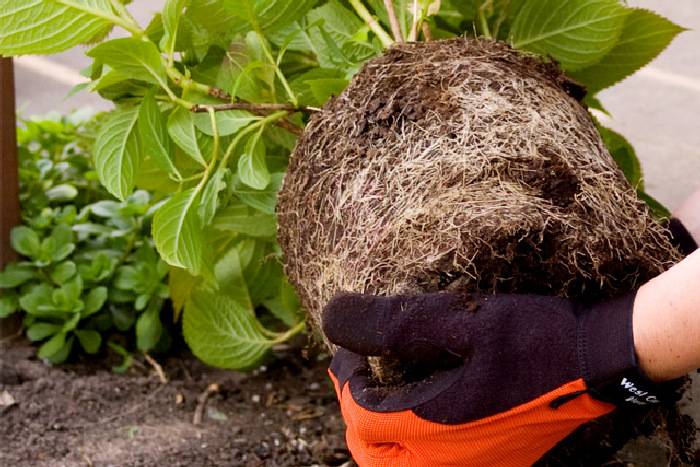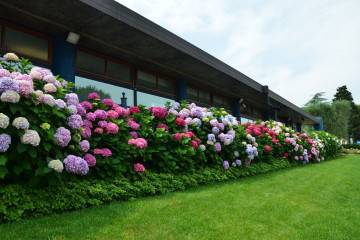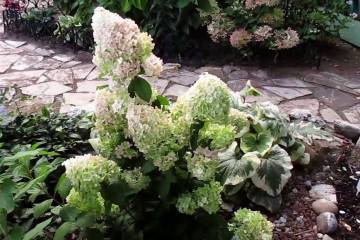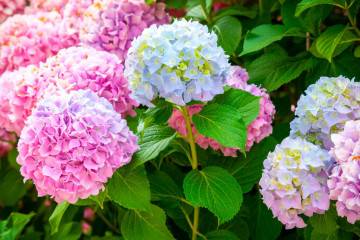Hydrangea Levana (Levana) paniculata - description
Content:
Hydrangea paniculata Levana is an ornamental shrub with large pyramid-shaped inflorescences, consisting of white and cream flowers. It is very popular, as it is distinguished by its rapid growth, frost resistance down to −25 ° C, unpretentious care, beautiful appearance and sweetish honey aroma that spreads throughout the site.
Hydrangea Tim van Leeuwen: variety description
Hydrangea Levana is a large shrub that keeps its shape well, is resistant to winds and bad weather. The flowers retain their white-cream color until the end of flowering. The plant is grown to decorate private plots, city parks, and create hedges.
Origin and appearance
The birthplace of the Levana hydrangea is North America, Japan and China. The plant is also common in the south of Sakhalin.
The shrub reaches a height of 2-3 m. The crown is dense, it does not lose its shape from strong wind and rain. Large, bright green leaves are ovoid or elliptical in shape with a pointed boat-like angle.
How hydrangea blooms
Hydrangea blooms from mid-summer to mid-autumn. Densely hairy panicles - inflorescences of white or cream color, cone-shaped, their length is up to 50 cm, flower diameter is 5-7 cm. Flowers are 4-cottony with rounded sepals.
The fruits of the Levana hydrangea are in the shape of a capsule up to 3 mm with small numerous seeds. The fruit cracks at the top.
Transplanting Levan's hydrangea after purchase in open ground
It is necessary to transplant the plant into open ground in early spring or autumn. Planting a seedling in the ground should be done in the morning or evening.
What is needed for landing
First of all, you need to find the right place. Then you should decide on the design, choose plants that will beautifully combine with the hydrangea, without shading or hiding it.
You also need to prepare a special top dressing, which is added when planting a shrub.
Choosing the best place
Hydrangea loves sunny places, but direct rays do not contribute to rapid growth and beautiful appearance. The shrub thrives in slightly shaded areas.
Hydrangea grows in lowlands with acidic soil. It is necessary to choose soil with a small amount of lime in the composition. If the soil is not acidic enough, you need to add peat or needles to it.
Step-by-step planting process
Planting Lebanese hydrangeas in open ground involves the following steps:
- First, dig a hole about 50 cm in diameter and 100 cm deep. You need to step back from other plants by 1-2 m.
- Pour 10-20 liters of water into the hole so that the soil becomes moist.
- Pour top dressing into the pit. In addition to mineral fertilizers, you need to buy or make a mixture of humus, sand and peat. You can also add potassium sulfide, superphosphate and urea.
- Then place the seedling in the hole and spread the roots well.
- After that, fill the hole with earth and tamp the soil.
- After planting, water the seedling well.
- To retain moisture, mulch the trunk circle using straw, peat, sawdust or hay.
Reproduction of hydrangea Levan
Hydrangea Lebanon can be propagated in three ways.
Propagation by cuttings
During the spring pruning process, you need to select young shoots 10 cm long and cut them at right angles. Each branch should have three pairs of buds. The cut site is treated with a special root growth stimulant, and the lower leaves are removed. Prepared shoots are placed in a mixture of sand and peat (2: 1) and watered. First, the cuttings need to be covered with foil, and after they have taken root, no shelter is required. The soil must be regularly moistened, and the plant must be sprayed.
Growing from cuttings
In early spring, the shrub releases young shoots. They need to be pressed to the ground and dug in, leaving a top about 20 cm long on the surface. The layers should be watered after a couple of days. When the plant is rooted, it should be separated from the mature shrub and transplanted to a new location.
Dividing the bush
An adult bush must be carefully dug up and the roots must be cut into several pieces with a sharp knife. Each should have a bud of growth. All parts must be immediately planted in open ground and watered abundantly.
Lebanese hydrangea care
In order for the shrub to grow beautiful and lush, you need to prune in time. Old branches should be removed completely, and young ones should be cut by two-thirds. Pruning is carried out in the spring, before the beginning of the growing season. Dried leaves and flowers also need to be pruned. To accelerate the growth and development of young shoots in the spring, the old ones are removed completely to the very root in the fall.
Watering mode
The plant is moisture-loving, it needs systematic watering, it does not tolerate drought well, but it is also impossible to overfill the shrub. Watering should be done in the morning or in the evening every other day. On hot, dry days, hydrangea should be watered daily.
Top dressing
If, when planting hydrangeas, a sufficient amount of fertilizer was added to the soil, then the first two years you can not use top dressing.
Starting from the third year, you need to adhere to a certain system:
- in the spring, hydrangea should be fertilized with fertilizing with nitrogen, potassium, phosphorus;
- when buds appear, the shrub needs to be fed again;
- then it is necessary 2-3 times during the flowering period to water the shrub with diluted settled manure or chicken droppings.
Features of care during the flowering period
Gardeners classify this hydrangea variety as moderately resistant to diseases and pests. Therefore, the shrub must be treated from time to time with special agents against fungi and bacteria.
Timely moderate watering, regular feeding are the main principles of caring for a shrub.
Features of care during the rest period
After the hydrangea has faded, it needs to be fed with phosphorus fertilizers. This will help strengthen the root system to survive the winter. Mulching the trunk circle and the lower part of the trunk will prevent the root system from freezing.
Preparing for winter
Before the onset of cold weather, the plant must be covered with a film or burlap. Despite the fact that hydrangea can withstand frost down to -30 ° C, the root system can freeze over, which will lead to the death of the plant.Young bushes just need to be pressed to the ground and covered. Large shrubs need to be wrapped with foil and tied with rope. After the end of the cold weather, the plant is freed from the shelter.
Hydrangea has won the hearts of many gardeners. A magnificent aroma, delicate flowers can create an unforgettable atmosphere on any site and cheer up its owners. In addition, this variety is distinguished by its unpretentious care, frost resistance and unsurpassed beauty. The plant, resistant to wind and bad weather, does not lose its attractiveness and keeps its shape well.


















